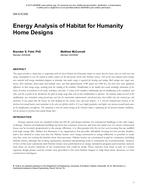This paper describes a study done in cooperation with the local Habitat for Humanity chapter to ensure that the houses that are built have low energy consumption to ease the burden of utility expense on the low-income clients that Habitat services. Two of the most popular house designs were modeled with energy simulation program to determine how much energy is required for heating and cooling. Both designs were single story houses, three bedrooms, about equal total window areas, and both approximately 1100 square feet (100 m2), but there were some significant differences in their energy usage, resulting from the shading of the windows. Modifications to the models were made including: orientation of the house, R-values of insulation in the walls, crawlspace and attic, U-values of the windows, conditioning and un-conditioning of the crawlspace and attic, and the set point of the thermostat; the effect of energy usage from each of these modifications is reported. An economic impact of each of the modifications was calculated, using present-day costs for the construction improvements and present-day, local utility rates for natural gas and electricity. It was found that the houses are well designed for the current rates and local climate. A 3 cent per kilowatt-hour increase in the electrical rate would make extra insulation in the attic cost effective (with a 4.5 year simple payback), and higher rate increases would make more of the modifications cost-effective. The conclusion is that the current design of the Habitat homes is optimized for the present economic conditions, but an increase in electrical rates would change that.
Citation: ASHRAE Conference Papers, Dallas, TX.
Product Details
- Published:
- 2013
- Number of Pages:
- 8
- File Size:
- 1 file , 530 KB
- Product Code(s):
- D-DA-13-C016
